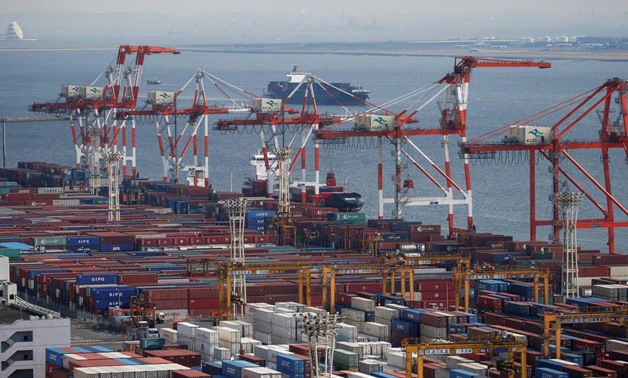
Shipping containers are seen at a port in Tokyo, Japan, March 22, 2017 - REUTERS/Issei Kato
CAIRO – 30 August 2018: Trade Exchange between Egypt and Bahrain recorded about $165 million per year, according to Director of Cairo Center for Economic Studies Abdel Maneam el-Said.
He clarified that the trade balance is in favor of Egypt, where Egypt exports furniture, equipment, vegetables, pulses and ceramics to Bahrain while the most important Egyptian imports from Bahrain are iron and oil derivatives and oils.
“Egypt can also open new markets for Egyptian products in Bahrain through the export of carpets, textiles, cotton and also marble, granite and cement,” he added.
Maneam noted that the Bahraini investments in Egypt reached $2.7 billion; ranking number 14 in the list of countries which invest in Egypt.
“Egypt can attract Bahraini investments by consolidating cooperation with the Bahraini government,” he said.
He also added that the state can attract Bahraini investors especially as the investment climate in Egypt has become attractive for investment and benefit from the decline of the Bahraini investment movement in Qatar.
Maneam clarified that Egypt signed with Bahrain a non-double taxation agreement and marine navigation trade agreement that can be used as a guideline to attract more Bahraini investments.
Regarding tourism, he referred to Bahrain’s tourism promotion for Egypt in cooperation with the Arab Federation of Tour Guides to support tourism in Egypt, after the visit of the Bahraini King to Egypt in Sharm el-Sheikh in 2017.
Egypt has been witnessing a drop in imports after it floated its currency in late 2016, making Egyptian goods in foreign markets cheaper while doubling the cost of importing.
Exports are considered to be one of the main sources of support to foreign reserves besides revenues of tourism, investments, remittance of expatriates and Suez Canal.
Egypt’s foreign reserves increased by $119 million by the end of June 2018 to reach $44.26 billion, compared to $44.14 billion by the end of May 2018, according to CBE’s data.
The state’s foreign reserves started to rebound since the delivery of the $12 billion three-year International Monetary Fund loan program in 2016.
The IMF Executive Board approved in November 2016 a three-year extended fund facility (EFT) loan to Egypt worth $12 billion to support its economic reform program.
Egypt received the fourth tranche of the International Monetary Fund’s (IMF) loan in June; the total disbarments Egypt got under the program reached $8 billion.
The current average of foreign reserves covers about eight months of Egypt's commodity imports, which is higher than the global average of about three months of commodity imports.
Egypt spends an average of $5 billion monthly on imports with an annual total of more than $60 billion.
Foreign currencies in Egypt’s foreign reserves include the U.S. dollar, euro, Australian dollar, Japanese yen and Chinese Yuan.
The main function of the foreign exchange reserve, including its gold and various international currencies, is to provide commodities, repay the installments on interest rates of external debt, and to cope with economic crises.
Egypt embarked on a bold economic reform program that included the introduction of taxes, such as the value-added tax (VAT), and cutting energy subsidies, with the aim of trimming the budget deficit.

Comments
Leave a Comment